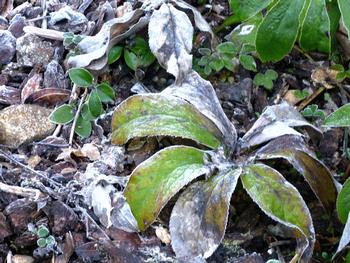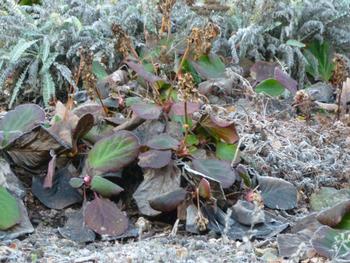Frost
-
Martha Proctor
-
As our gardens transition from fall into winter and from drought to beginning a slow but partial recovery from lack of rain, we need to think about what we can do to help protect our plants before and after a frost or freeze. Within a single garden, some areas may be affected by frost while others are not. For instance, the ground may have frost, while the leaves on plants do not. Plants closer to a building may be safe, while those a few feet away are affected.
 Hellebore after several days of frost. Photo: Martha Proctor
Hellebore after several days of frost. Photo: Martha ProctorFreezes are different from frosts. We have a "freeze" when temperatures dip below 32°F . A "frost" happens when moisture in the air during low temperatures causes ice crystals to form on surfaces like leaves.
There are two different types of frost: advection and radiation. Frost damage occurs during an advection freeze when temperatures of 32°F or below are sustained for several days. Advection freezes occur when an air mass with temperatures below freezing displaces warmer air causing air temperatures of plants to become low enough for ice crystals to form within their tissues. This process makes water inaccessible to plant tissues and interrupts the movement of fluids. Radiation frosts occur during the night. The ground cools by radiation to the sky. The cold ground chills the air close to the ground with a warm layer above it.
Plants are classified according to the minimum temperatures they tolerate. "Hardy" plants tolerate some short-term freezing, while "tender" plants are noticeably injured or even killed by freezing temperatures. Most plants suffer if temperatures fall below 25°F.
Frost-tender plants suffer much sooner than hardier plants, i.e., the softest tissues, e.g., leaves and tender new shoots, are affected first. Tougher stem tissue and buds sustain less damage but are not immune if the temperatures remain low for several days in a row: the longer and more intense the freeze, the more severe the frost damage.
Defensive measures which lessen the impact of frost damage include: Frost damage in a winter garden. Photo: Martha Proctor
Frost damage in a winter garden. Photo: Martha Proctor- Knowing the average risk of frost in Marin is from November 5 through March 30
- Susceptible plants are more likely to sustain a frost if planted near a fence, canopy or structure and in more elevated spots in the garden
- Water the soil thoroughly (except around succulents) before nightfall when frost is forecast - wet soil holds heat better than dry soil
- Irrigate during a frost as water helps raise plant temperatures and the air around them to that of water
- Cover vulnerable plants with row covers (synthetic polyethylene or all-purpose garden fabric), old sheets, cardboard boxes etc. - remove the cover during the day so plants can breathe and receive sunlight; make sure that whatever you use does not block out sunlight and irrigation
- Add a straw or leaf mold mulch to regulate soil temperature and retain moisture
- Cluster container plants close to the house and wrap pots in burlap or bubble wrap to help insulate roots
If plants show signs of frost damage, do not prune off the affected parts or dig up the plant immediately. Instead, wait until the weather warms up in March to see whether new leaves appear. Pruning too soon increases the risk of infection. In any case, the dead leaves and stems will provide limited insulation from further frost damage. Once you see new healthy growth at the base of the plant in spring, prune off the damaged parts. If no new growth occurs, replace the dead plant with a more cold-tolerant "hardy" species. Unfortunately, even if you perform all the above preventative methods, some plants or parts of plants will still succumb to frost damage. However, your garden will fare better if you follow the suggested guidelines.


